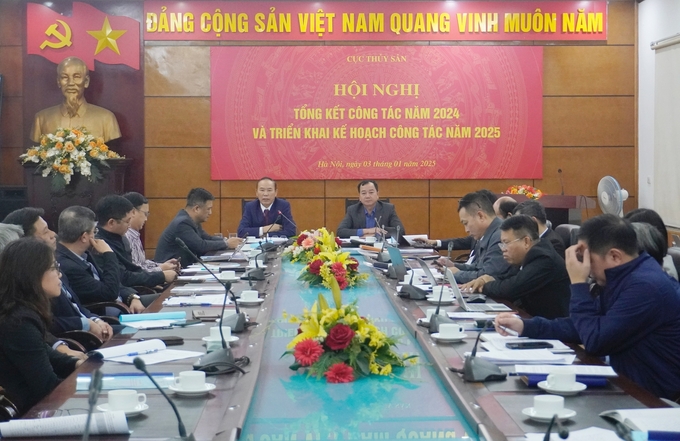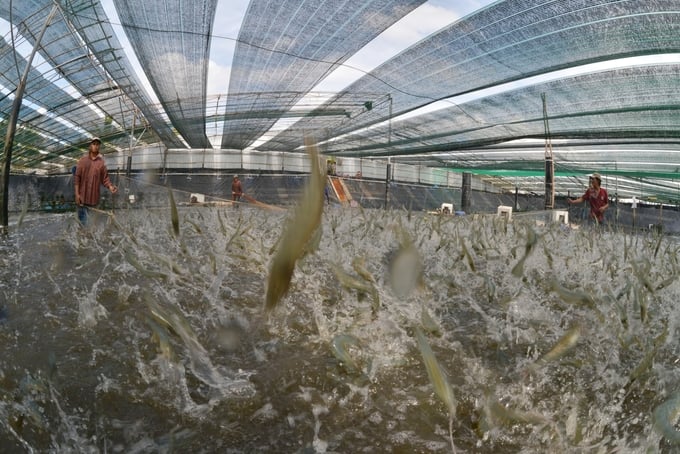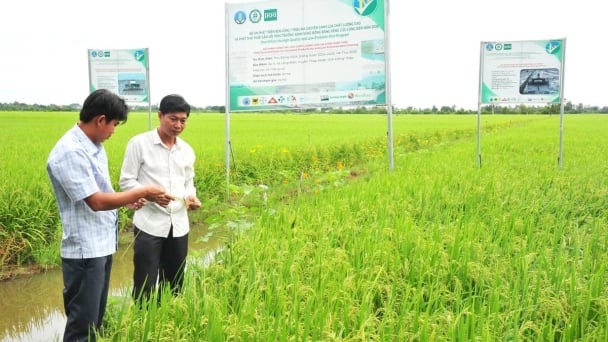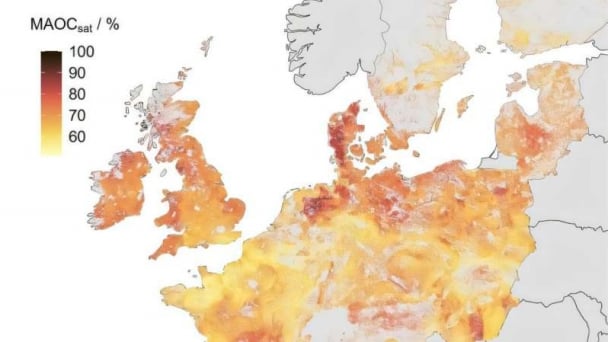April 17, 2025 | 15:44 GMT +7
April 17, 2025 | 15:44 GMT +7
Hotline: 0913.378.918
April 17, 2025 | 15:44 GMT +7
Hotline: 0913.378.918
At the conference to review the 2024 work results and outline the 2025 plan held on January 3 in Hanoi, Mr. Pham Quang Toan, Deputy Director of the Directorate of Fisheries (Ministry of Agriculture and Rural Development), reported that by the end of December 2024, the total seafood production is expected to reach over 9.6 million tons, a 2% increase compared to 2023. This includes nearly 3.86 million tons of captured seafood and over 5.75 million tons of farmed seafood. Seafood export value is estimated to exceed 10 billion USD.

Deputy Minister of Agriculture and Rural Development Phung Duc Tien stated that there is still significant potential for growth in the fisheries sector. Photo: Hong Tham.
Mr. Toan assessed that "Aquaculture has developed steadily, achieving 101.3% of the planned target, and has increased by 4% compared to 2023. Seafood export value has reached 106% of the target, with a growth of 12.1% compared to the previous year".
However, Mr. Toan pointed out that the sector still faces several shortcomings and limitations. Many aquaculture regions still lack adequate infrastructure. Additionally, the water supply systems used for aquaculture are primarily shared with irrigation systems serving agricultural production, which do not meet the technical requirements necessary for efficient and sustainable aquaculture practices.
Although there has been some investment in fishing port infrastructure and storm shelter areas, these facilities still fall short of meeting the growing demands of the industry. Furthermore, maintenance and repair work on these facilities have not received the necessary attention or funding from local authorities, and resources are not allocated in accordance with the regulations.
The application and transfer of scientific and technological advancements in both fishing and aquaculture are still limited. Additionally, the integration and coordination across the production, processing, and consumption stages of seafood products are not yet sufficiently strong or well-established.
Mr. Toan emphasized, "The increase in seafood catch compared to the 2024 target has led to difficulties in meeting the goals set by the Fisheries Development Strategy for 2030, which aims to reduce the catch to 2.8 million tons".

The conference to review the 2024 work results and outline the 2025 plan of the Directorate of Fisheries took place on the morning of January 3 in Hanoi. Photo: Hong Tham.
The Director of the Directorate of Fisheries, Tran Dinh Luan, also provided additional insights, stating that over the past year, efforts to boost aquaculture in reservoirs have led to many positive outcomes. In particular, the export of tilapia has shown encouraging growth, especially in the northern region. In addition, species such as eel and frog are emerging as promising options for future development in the sector.
Mr. Luan also emphasized that while aquaculture still holds significant potential and advantages for expansion, achieving sustainable development in the long term will require careful planning and organization from the very beginning. He warned against the risks of spontaneous and unregulated growth.
Mr. Pham Quang Toan, Deputy Director of the Directorate of Fisheries, emphasized that 2025 will be a pivotal year for accelerating progress and pushing forward to achieve the goals of the 5-year Fisheries Development Plan for the 2021–2025 period. At the same time, preparations will be made for the 2026–2030 Fisheries Development Plan. The Directorate of Fisheries will continue to implement the provisions of the 2017 Fisheries Law in a coordinated and unified manner, ensuring that both central and local governments follow the regulations and guidelines set forth in the Fisheries Development Strategy, which outlines objectives for 2030 and a vision toward 2045.
Furthermore, the Directorate will maintain its focus on the strategic goal of reducing reliance on wild fisheries while increasing aquaculture production. This will involve the comprehensive and synchronized execution of national programs, schemes, and development plans that have already been approved by the Prime Minister and the Minister of Agriculture and Rural Development.

Species that already have advantages, such as shrimp, catfish and mollusks, need to improve productivity in the coming period. Photo: Hong Tham.
Additionally, the fisheries sector will continue to pursue a development strategy that emphasizes sustainability, adaptation to climate change, and improving the competitiveness of Vietnamese seafood products in international markets. A key part of this strategy is shifting the sector's focus from simply production-oriented thinking to a more comprehensive economic approach to fisheries. This includes moving from a model of growth based on single-value outputs to one that promotes integrated, multi-value growth across various areas of the industry.
Mr. Le Thanh Hoa, Deputy Director of the Department of Quality, Processing, and Market Development (Ministry of Agriculture and Rural Development), highlighted that Vietnam's seafood export value in 2024 has already exceeded the significant milestone of 10 billion USD, which represents a collective success for the entire sector. However, he pointed out that in 2025, greater attention must be given to monitoring antibiotic residues in exported seafood shipments.
On the market front, Mr. Hoa mentioned that the Department of Quality, Processing and Market Development would continue to closely collaborate with the Department of Animal Health to monitor disease outbreaks, with the goal of facilitating the reopening of the Saudi Arabian market for Vietnamese shrimp and farmed fish. At the same time, efforts will be made to engage in more active negotiations and explore new opportunities to strengthen exports to the Chinese market.
Meanwhile, Mr. Tran Dinh Luan, Director of the Directorate of Fisheries, emphasized that there are two primary areas that the fisheries industry will prioritize in 2025. The first is ensuring more stringent control over the quality of shrimp seed, and all other aquatic seedlings. The second is to further regulate the use of antibiotics in aquaculture.
Deputy Minister of Agriculture and Rural Development (MARD), Phung Duc Tien, provided an assessment of the fisheries sector in 2024, noting several significant highlights. The total seafood production reached 9.6 million tons, with seafood export value exceeding 10 billion USD, marking a major achievement for the industry. Furthermore, disbursement of funds was completed at 100%. He also emphasized that the Directorate of Fisheries has demonstrated a high degree of unity, working collaboratively in a well-coordinated and efficient manner.
Looking ahead to 2025, Deputy Minister Phung Duc Tien outlined several key priorities. He emphasized the need to continue refining the legal framework to ensure that policies and regulations are not only developed but are also practical and effectively implemented at the local level. He particularly stressed that there should be no delays in the issuance of standards and regulations, stating: "Don’t delay today’s work for tomorrow".
The Deputy Minister further pointed out that the fisheries sector still has considerable room for growth. For sectors such as shrimp, catfish, and mollusks, which already have a competitive advantage, the focus should be on improving productivity. This includes addressing issues like the overuse of antibiotics, disease management, and tightening controls on the quality of shrimp seedlings, feed, and overall nutrition to ensure long-term sustainability. He also called for the promotion of emerging aquaculture species with high potential, such as seaweed, eel, and tilapia.
On the issue of combating illegal, unreported and unregulated (IUU) fishing, Deputy Minister Phung Duc Tien emphasized the need to continue enhancing the management of the fishing fleet. This includes improving the monitoring of vessels through Vessel Monitoring Systems (VMS), strengthening the enforcement of administrative penalties and ensuring the traceability of seafood products. He also pointed out that local authorities must conduct thorough inspections both before, during and after the Lunar New Year holidays to prevent violations and ensure compliance with regulations.

Aquaculture production in 2024 reached over 5.75 million tons, marking a 4% increase compared to 2023. Photo: Hong Tham.
In terms of science and technology, Deputy Minister Phung Duc Tien recognized the significant contributions that science and technology have made to the fisheries sector over time. However, he emphasized that, given the changing landscape, a more profound transformation is needed. "Science must be grounded in reality; it should be driven by practical needs and must directly serve the needs of the industry and society", he stated.
Additionally, Deputy Minister Tien highlighted the critical need to invest in and upgrade infrastructure. He stressed the importance of deepening international cooperation to foster knowledge exchange and enhance competitiveness in global markets. There is also a need to prioritize the development of processing capacities, market expansion and improved coordination with other stakeholders to ensure a more integrated approach to the sector’s growth.
Furthermore, he pointed out that effective communication efforts will be key to building awareness and promoting the sector’s progress. He also underscored that the global shift towards green and sustainable practices is an unavoidable trend.
Although the fisheries sector faced significant challenges in 2024, particularly following Typhoon No. 3 (Typhoon Yagi), it has made commendable progress overall. The sector managed to tap into its internal strengths, and the leadership’s direction and coordination efforts have proven effective. However, 2025 will be an important year, with much still to be done. This year is crucial as it will set the stage for the successful completion of the 5-year Fisheries Development Plan for 2021–2025. Furthermore, it will serve as the foundation for preparing the Fisheries Development Plan for the 2026–2030 period.
Fisheries sector outlook for 2025:
- Aquaculture area: The total aquaculture area is projected to exceed 1.3 million hectares, marking a 2% increase compared to 2024. Of this, approximately 390.000 hectares will be dedicated to freshwater aquaculture, while around 937.000 hectares will be used for brackish and saltwater aquaculture.
- Total production: The sector is expected to achieve a total production of approximately 9.6 million tons, maintaining levels similar to 2024. This includes nearly 3.66 million tons from wild-caught fisheries, representing a 5.2% decrease compared to the previous year. In contrast, aquaculture production is projected to rise to over 5.95 million tons, showing a 3.5% increase compared to 2024.
- Export value: The fisheries sector's export revenue is forecast to reach approximately 10.5 billion USD in 2025.
Translated by Phuong Linh

(VAN) The UN Deputy Secretary-General recognized Vietnam as a pioneer in reducing greenhouse gas emissions and achieving a just energy transition.

(VAN) Vietnam and the UAE are shifting from traditional economic ties to a strategic partnership focused on green transformation and food security.

(VAN) At P4G Summit, Minister Do Duc Duy calls for partners to 'sow the seeds of technology' and cultivate cooperation to bear fruit for a green future.

(VAN) Vietnam is choosing a strategic path, pursuing rapid yet sustainable development, fostering innovation while remaining in harmony with nature, and integrating globally while preserving its cultural identity.

(VAN) This remarks was made by Mr. Máximo Torero, Chief Economist of the Food and Agriculture Organization of the United Nations (FAO), during a meeting with Vietnam's Deputy Minister of Foreign Affairs Nguyen Minh Hang.

(VAN) The study concludes that the majority of EU agricultural soils require additional protective measures, such as cover cropping, improved crop rotations, reduced tillage, deep rooting crops, increasing organic amendments and agroforestry.

(VAN) Prime Minister Pham Minh Chinh chaired the official welcoming ceremony for high-level delegations attending the P4G Summit 2025 and visiting green startup business booths.